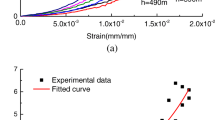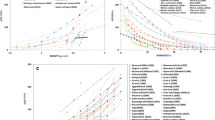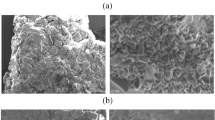Abstract
Despite the application of numerous geophysical methods in interpreting lithology, only a few are able to predict the mechanical properties of rocks correctly. It is also difficult to obtain data on mechanical rock properties for laboratory testing because it is expensive and requires full core drilling. Conversely, obtaining data of geophysical log is relatively easier because it is quite abundant due to the exploration in open hole and full core drilling. The mechanical properties will be very helpful for analysis, assuming it is easily determined by the geophysical approach. This research aims to model the relationship between mechanical properties and geophysical log data. Data on short density and gamma-ray were collected from laboratory testing known as ASTM and by measuring the boreholes. The data collected were then analyzed to determine the cohesion and friction angle. Specific analysis was carried out on clastic sedimentary rocks with low mechanical properties. The clastic sedimentary rocks are composed of mostly fine-grained to sand-sized quartz minerals. The analysis method was used to determine the relationship between the variables by performing simple linear regression. The result showed that geophysical log data's prediction model of mechanical properties produced an error of 19.71% to 56.14%. Furthermore, the mechanical properties and geophysical log data did not have a strong correlation. Therefore, it is recommended to conduct laboratory testing on the rock samples to determine their mechanical properties. This is possibly performed by multiplying samples with the same geological characteristics to produce a better distribution of data in statistical analysis.
Article highlights
-
1.
The prediction mechanical properties of sedimentary rock can be determined with the geophysical method.
-
2.
The mechanical properties will be very helpful for analysis, assuming it is easily determined by the geophysical approach.
-
3.
Mechanical properties of fine-grained sedimentary rocks do not strongly correlate with the values of long spaced density (LSD), short spaced density (SSD), and gamma-ray.




Similar content being viewed by others
Explore related subjects
Discover the latest articles, news and stories from top researchers in related subjects.References
Al-Kattan W, Al-Ameri NJ (2012) Estimation of the rock mechanical properties using conventional log data in north Rumaila field. Iraqi J Chem Pet Eng 13(4):27–33
Altindag R (2012) Correlation between P-wave velocity and some mechanical properties for sedimentary rocks. J South African Inst Min Metall 112:229–237
Azahar MA, Mahadi NFZ, Rusli QN, Narendranathan N, Lee EC (2019) Use of geophysics for site investigations and earthworks assessments. IOP Conf Series Mater Sci Eng 512:012007
Baibatsha A, Satibekova S, Baibatchayeva Z (2019) Application of geophysical well logging data to assess the physical-mechanical properties of rocks. In: Sixteenth international congress of the brazilian geophysical society, pp. 1–6
Belougne V, Faivre O, Jammes L, Whittaker S (1996) Real time speed correction of logging data. In: SPWLA 37th Annu. Logging Symp., 16–19 June 1996
Bieniawski ZT, Bernede MJ (1979) Suggested methods for determining the uniaxial compressive strength and deformability of rock materials: Part 1. Suggested method for determining deformability of rock materials in uniaxial compression. Int J Rock Mech Miner Sci Geomech Abstr 16(2):135e40. https://doi.org/10.1016/0148-9062(79)91451-7
Borsaru M, Zhou B, Aizawa T, Karashima H, Hashimoto T (2005) Automated lithology prediction from PGNAA and other geophysical logs. Appl Radiat Isot 64(2):272–282. https://doi.org/10.1016/j.apradiso.2005.07.012
Castagna JP, Batzle ML, Eastwood RL (1985) Relationship between compressional wave and shear wave velocities in clastic silicate rocks. Geophysics 50(4):571–581. https://doi.org/10.1190/1.1441933
Chary KB, Sarma LP, Lakshmi KP, Vijayakumar NA, Lakshmi VN, Rao MV (2006) Evaluation of engineering properties of rock using ultrasonic pulse velocity and uniaxial compressive strength. In: Proc Natl Sem Non-destr Eval, pp. 379-385
Cheng H, Hu ZY (2003) Some factors affecting the uniaxial strength of weak sandstone. Bull Eng Geol Environ 62(4):323–332. https://doi.org/10.1007/s10064-003-0207-4
Darmadi D (2015) Analisis data well logging untuk rekonstruksi lingkungan pengendapan batubara daerah pangandonan, Sumatera Selatan. Bachelor thesis, Faculty of Engineering, Universitas Lampung, Lampung
Fei W, Huiyuan B, Jun Y, Yonghao Z (2016) Correlation of dynamic and static parameters of rock. Electron J Geotech Eng 21(4):1551e60
Fiorucci M, Iannucci R, Lenti L et al (2017) Nanoseismic monitoring of gravity-induced slope instabilities for the risk management of an aqueduct infrastructure in Central Apennines (Italy). Nat Hazards 86:345–362. https://doi.org/10.1007/s11069-016-2516-5
Gaviglio P (1989) Longitudinal waves propagation in a limestone: the relationship between velocity and density. Rock Mech Rock Eng 22(4):299–306. https://doi.org/10.1007/bf01262285
Harsono A (1997) Evaluasi formasi dan aplikasi log, 8th edn. Schlumberger Oilfield Services, Jakarta
Hartono HG (2020) Geomechanic properties and provenance analysis of quartz sandstone from the Warukin formation. GEOMATE J 18(66):140–149. https://doi.org/10.21660/2020.66.50081
Hiden H, Ardianto T, Minardi S, Taurida A, Muhajirah M (2018) Determination of material characteristics and shear wave velocity of volcanic sediment layer of mount samalas using MASW technique. Preprints, pp. 1–14. doi:https://doi.org/10.20944/preprints201809.0116.v1
Hussain Y, Cardenas-Soto M, Martino S, Moreira C, Borges W, Hamza O, Prado R, Uagoda R, Rodríguez-Rebolledo J, Silva RC, Martinez-Carvajal H (2019) Multiple geophysical techniques for investigation and monitoring of Sobradinho landslide, Brazil. Sustainability 11(23):6672
Surtech Indonesia, 2018. Technical Specification GDDC. Surtech Indonesia, Tangerang
Kahraman S, Ulker U, Delibalta MS (2007) A quality classification of building stones from P-wave velocity and its application to stone cutting with gang saws. J South Afr Inst Min Metall 107(7):427–430
Kerzner MG (1998) Optimized speed correction. In: SPWLA 39th Annu. Logging Symp., 26–28 May
Khandelwal M (2013) Correlating P-wave velocity with the physico-mechanical properties of different rocks. Pure Appl Geophys 170(4):507e14. https://doi.org/10.1007/s00024-012-0556-7
Maákowski P, Ostrowski A (2017) The methodology for the Young modulus derivation for rocks and its value. Procedia Eng 191:134–141
Mahmoud AA, Elkatatny S, Ali A, Moussa T (2019) Estimation of static young’s modulus for sandstone formation using artificial neural networks. Energies 12(11):2125. https://doi.org/10.3390/en12112125
McCall DC, Gardner JS (1982) Litho-density log applications in the Michigan and Illinois basins. In: SPWLA 23rd Annu Logging Symp., 6–9 July 1982
Nourani MH, Moghadder TM, Safari M (2017) Classification and assessment of rock mass parameters in Choghart iron mine using P-wave velocity. J Rock Mech Geotech Eng 9(2):318–328. https://doi.org/10.1016/j.jrmge.2016.11.006
Parapuram GK, Mokhtari M, Hmida JB (2017) Prediction and analysis of geomechanical properties of the upper Bakken shale utilizing artificial intelligence and data mining. In: Unconv Resour Tech Conf (URTeC), pp. 2815–2833 https://doi.org/10.15530/urtec-2017-2692746
Pazzi V, Morelli S, Fanti R (2019) A review of the advantages and limitations of geophysical investigations in landslide studies. Int J Geophys 2019:27. https://doi.org/10.1155/2019/2983087
Pickel W, Kus J, Flores D, Kalaitzidis S, Christanis K, Cardott BJ, Misz-Kennan M, Rodrigues S, Hentschel A, Hamor-Vido M, Crosdale P, Wagner N (2017) Classification of liptinite—ICCP system 1994. Int J Coal Geol 169:40–61. https://doi.org/10.1016/j.coal.2016.11.004
Priest J, Frost E, Quinn T (2013) Speed matters: effects of logging speed on log resolution and log sampling. In: SPWLA 54th Annu. Logging Symp., 22–26 June 2013.
Rahmouni A, Boulanouar A, Boukalouch M, Géraud Y, Samaouali A, Harnafi M, Sebbani J (2013) Prediction of porosity and density of calcarenite rocks from P-wave velocity measurements. Int J Geosci 4(9):1292–1299. https://doi.org/10.4236/ijg.2013.49124
Reeves DR (1971) In-situ analysis of coal by borehole logging techniques. Can Min Metall Bull 64(706):67–75
Rodríguez-Sastre MA, Calleja L (2006) The determination of elastic modulus of slates from ultrasonic velocity measurements. In: Proc 10th Congress IAEG, pp. 775
Share B (2018) Correlations between ultrasonic pulse wave velocities and rock properties of quartz-mica schist. J Rock Mech Geotech Eng 10(3):594–602. https://doi.org/10.1016/j.jrmge.2018.01.006
Sudjana (1996) Metode Statistika, 6th edn. Tarsito, Bandung
Supandi S (2020) Impact of logging speed on sedimentary rock identification based on long and short density log. Int J GEOMATE 20(79):125–131. https://doi.org/10.21660/2021.79.J2025
Supandi S, Zakaria Z, Sukiyah E, Sudradjat A (2019) The influence of kaolinite-illite toward mechanical properties of claystone. Open Geosci 11(1):440–446. https://doi.org/10.1515/geo-2019-0035
Supandi Zakaria Z, Sukiyah E, Sudradjat A (2018) The correlation of exposure time and claystone properties at the Warukin formation. Int J GEOMATE 15(52):160–167
Supandi Zakaria Z, Sukiyah E, Sudradjat A (2020) New constants of fracture angle on quartz sandstone. Int J Adv Sci Eng Inf Technol 10(4):1597–1603. https://doi.org/10.18517/ijaseit.10.4.8272
Yang J, Fu LY, Fu BY, Wang Z, Hou W (2021) High-temperature effect on the material constants and elastic moduli for solid rocks. J Geophys Eng 18(4):583–593. https://doi.org/10.1093/jge/gxab037
Yasir SF, Abbas HA, Jani J (2018) Estimation of soil young modulus based on the electrical resistivity imaging (ERI) by using regression equation. AIP Conf Proc 2020:020071. https://doi.org/10.1063/1.5062697
Zhou B, Guo H (2020) Applications of geophysical logs to coal mining—some illustrative examples. Resour 9(2):11. https://doi.org/10.3390/resources9020011
Zohra-Hadjadj F, Laredj N, Maliki M, Missoum H, Bendani K (2019) Laboratory evaluation of soil geotechnical properties via electrical conductivity. Revista Facultad De Ingeniería, Univ De Antioquia 90:101–112
Acknowledgements
The author would like to thank the management of PT Borneo Indobara for supporting this research.
Author information
Authors and Affiliations
Corresponding author
Ethics declarations
Conflict of interest
The authors declare that they have no known competing financial interests or personal relationships that could have appeared to influence the work reported in this paper.
Additional information
Publisher's Note
Springer Nature remains neutral with regard to jurisdictional claims in published maps and institutional affiliations.
Rights and permissions
About this article
Cite this article
Sujatono, S. Determination of cohesion and friction angle on sedimentary rock based on geophysical log. Geomech. Geophys. Geo-energ. Geo-resour. 8, 33 (2022). https://doi.org/10.1007/s40948-022-00343-z
Received:
Accepted:
Published:
DOI: https://doi.org/10.1007/s40948-022-00343-z




